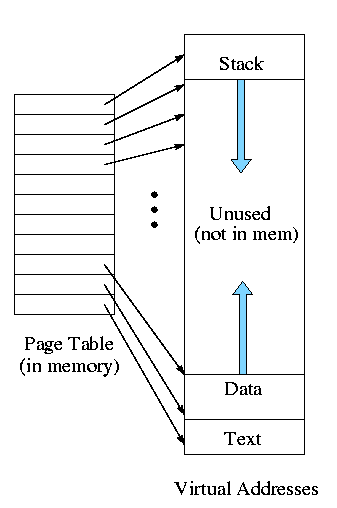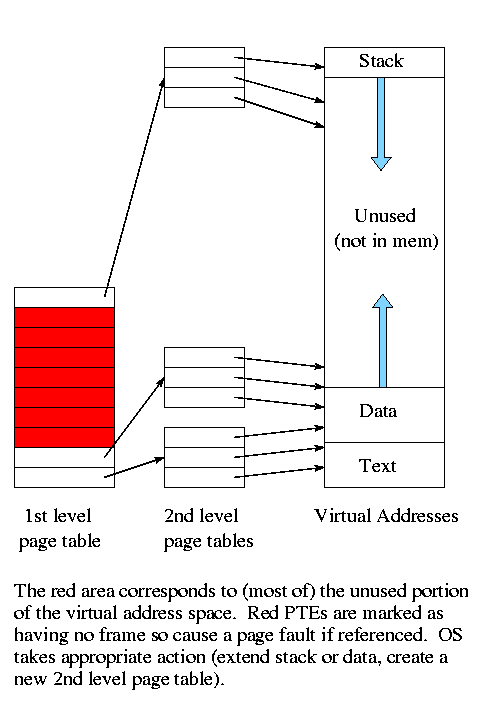Operating Systems
================ Start Lecture #17 ================
Note on midterm grades:
The grades on the midterm ranged from 56-95, with a median of 82.
The distribution was
90-100: 4
80-99: 14
70-79: 6
60-69: 3
50-59: 2
Fairly normal except too few high grades, which appears to be
caused by a rather poor showing on resource allocation/deadlock
chapter.
In particular, despite my explicit mention of initial claims in class
and saying something like “If the question include 'safe' the
answer should include 'initial claims'”, and my doing one of
these questions on the practice midterm answers, almost everyone forgot
the initial claims and drew pictures that might or might not be safe.
Midterm letter grades:
Since the midterm is worth four times each lab and only one lab was
graded, I computed the midterm letter grade with the same four to one
ratio. I did not give pluses and minuses, but definitely do for final
grades.
If you did not take the midterm, you received a UE (unable to evaluate).
Several students have not done lab1; this affected their grade.
Review of Midterm exam
4.3.2: Page tables
A discussion of page tables is also appropriate for (non-demand)
paging, but the issues are more acute with demand paging since the
tables can be much larger. Why?
-
The total size of the active processes is no longer limited to the
size of physical memory. Since the total size of the processes is
greater, the total size of the page tables is greater and hence
concerns over the size of the page table are more acute.
-
With demand paging an important question is the choice of a victim
page to page out. Data in the page table
can be useful in this choice.
We must be able access to the page table very quickly since it is
needed for every memory access.
Unfortunate laws of hardware.
-
Big and fast are essentially incompatible.
-
Big and fast and low cost is hopeless.
So we can't just say, put the page table in fast processor registers,
and let it be huge, and sell the system for $1000.

The simplest solution is to put the page table in main memory.
However it seems to be both too slow and two big.
-
Seems too slow since all memory references require two reference.
-
This can be largely repaired by using a TLB, which is fast
and, although small, often captures almost all references to
the page table.
-
For this course, officially TLBs “do not exist”,
that is if you are asked to perform a translation, you should
assume there is no TLB.
-
Nonetheless we will discuss them below and in reality they
very much do exist.
-
The page table might be too big.
-
Currently we are considering contiguous virtual
addresses ranges (i.e. the virtual addresses have no holes).
-
Typically put the stack at one end of virtual address and the
global (or static) data at the other end and let them grow towards
each other.
-
The virtual memory in between is unused.
-
That does not sound so bad.
Why should we care about virtual memory?
-
This unused virtual memory can be huge (in address range) and
hence the page table (which is stored in real memory
will mostly contain unneeded PTEs.
-
Works fine if the maximum virtual address size is small, which
was once true (e.g., the PDP-11 of the 1970s) but is no longer the
case.
-
The “fix” is to use multiple levels of mapping.
We will see two examples below: two-level paging and
segmentation plus paging.
Contents of a PTE
Each page has a corresponding page table entry (PTE).
The information in a PTE is for use by the hardware.
Why must it be tailored for the hardware and not the OS?
Because it is accessed frequently.
But actually some systems (software TLB reload) do not have hardware access.
Information set by and used by the OS is normally kept in other OS tables.
The page table format is determined by the hardware, so access routines
are not portable.
The following fields are often present.
-
The valid bit. This tells if
the page is currently loaded (i.e., is in a frame). If set, the frame
number is valid.
It is also called the presence or
presence/absence bit. If a page is accessed with the valid
bit unset, a page fault is generated by the hardware.
-
The frame number. This field is the main reason for the
table.
It gives the virtual to physical address translation.
-
The Modified bit. Indicates that some part of the page
has been written since it was loaded. This is needed if the page is
evicted so that the OS can tell if the page must be written back to
disk.
-
The referenced bit. Indicates that some word in the page
has been referenced. Used to select a victim: unreferenced pages make
good victims by the locality property (discussed below).
-
Protection bits. For example one can mark text pages as
execute only. This requires that boundaries between regions with
different protection are on page boundaries. Normally many
consecutive (in logical address) pages have the same protection so
many page protection bits are redundant.
Protection is more
naturally done with segmentation.

Multilevel page tables (Not on 202 final exam)
Recall the previous diagram. Most of the virtual memory is the
unused space between the data and stack regions. However, with demand
paging this space does not waste real memory. But the single
large page table does waste real memory.
The idea of multi-level page tables (a similar idea is used in Unix
i-node-based file systems, which we study later when we do I/O) is to
add a level of indirection and have a page table containing pointers
to page tables.
-
Imagine one big page table.
-
Call it the second level page table and
cut it into pieces each the size of a page.
Note that many (typically 1024 or 2048) PTEs fit in one page so
there are far fewer of these pages than PTEs.
-
Now construct a first level page table containing PTEs that
point to these pages.
-
This first level PT is small enough to store in memory. It
contains one PTE for every page of PTEs in the 2nd level PT. A
space reduction of one or two thousand.
-
But since we still have the 2nd level PT, we have made the world
bigger not smaller!
-
Don't store in memory those 2nd level page tables all of whose PTEs
refer to unused memory. That is use demand paging on the (second
level) page table
Address translation with a 2-level page table
For a two level page table the virtual address is divided into
three pieces
+-----+-----+-------+
| P#1 | P#2 | Offset|
+-----+-----+-------+
-
P#1 gives the index into the first level page table.
-
Follow the pointer in the corresponding PTE to reach the frame
containing the relevant 2nd level page table.
-
P#2 gives the index into this 2nd level page table
-
Follow the pointer in the corresponding PTE to reach the frame
containing the (originally) requested frame.
-
Offset gives the offset in this frame where the requested word is
located.
Do an example on the board
The VAX used a 2-level page table structure, but with some wrinkles
(see Tanenbaum for details).
Naturally, there is no need to stop at 2 levels. In fact the SPARC
has 3 levels and the Motorola 68030 has 4 (and the number of bits of
Virtual Address used for P#1, P#2, P#3, and P#4 can be varied).


